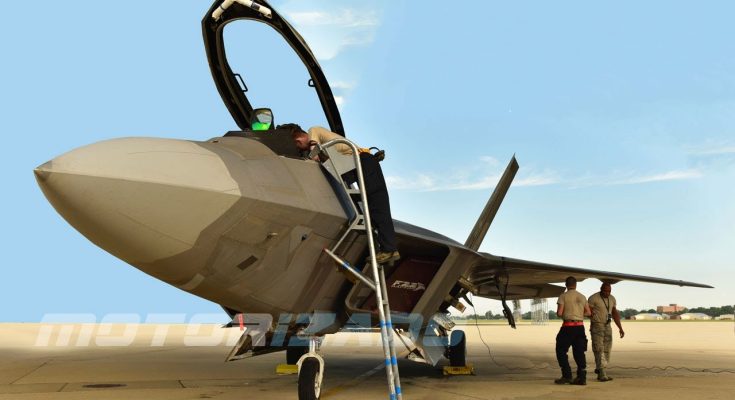The F-22 Raptor is widely regarded as one of the most advanced fighter jets in the world, thanks to its unmatched stealth, agility, and cutting-edge technology. However, despite its incredible capabilities, there is one major reason why no other country can buy the F-22 Raptor: U.S. government restrictions on the aircraft’s sale to foreign nations. This decision, driven by a combination of strategic, security, and technological concerns, ensures that the F-22 Raptor remains an exclusive asset of the U.S. Air Force.
The Reasons Behind the Ban
- Technological Superiority and Security Concerns The F-22 Raptor is equipped with highly sensitive and classified technologies, particularly in the areas of stealth, radar systems, and sensor fusion. The aircraft’s low radar cross-section, combined with its advanced avionics, makes it nearly invisible to enemy radar systems. This technology gives the U.S. a significant edge in air superiority, and the government is unwilling to share it with other countries, fearing that it could be reverse-engineered or sold to adversaries.
Additionally, the radar and sensor systems integrated into the F-22 are highly sophisticated, allowing the aircraft to detect and engage targets at long ranges while maintaining its own stealth profile. The U.S. government views these capabilities as essential to its national security and is determined to protect them from falling into the wrong hands. By limiting foreign sales, the U.S. ensures that this technological advantage remains exclusive.
- The “Raptor Ban” Law (2006) The primary legal barrier preventing the sale of the F-22 to foreign countries is the “Obey Amendment”, which was passed as part of the 2006 U.S. defense spending bill. This amendment specifically prohibits the U.S. government from exporting the F-22 to any other country, regardless of the buyer’s military relationships with the United States. While this restriction was originally put in place to protect the aircraft’s technology, it remains a legal impediment to the export of the F-22 to this day.
The law was enacted after concerns that countries such as Japan, Israel, and Australia—all close U.S. allies—might be interested in purchasing the F-22 for their own air forces. Even though these nations have been loyal partners to the U.S., the government felt that the F-22’s capabilities were too advanced to share, particularly given the potential risks of those nations being targeted by rival powers seeking to gain access to the jet’s cutting-edge technologies.
- Global Strategic Imbalance One of the concerns surrounding the export of the F-22 is the potential for it to upset the global balance of power. As the only fifth-generation fighter currently in service with the U.S. Air Force (at least in terms of air superiority), the F-22 represents a key component of America’s military dominance. If other countries were allowed to acquire the F-22, it could shift the strategic landscape and potentially endanger U.S. interests abroad.
For example, if a nation like China or Russia were able to obtain an F-22 (either through sale or espionage), they would be able to study its systems and technology in detail, which could directly undermine U.S. air superiority. The U.S. government recognizes the importance of maintaining an edge in air combat, and allowing foreign sales of the F-22 would potentially jeopardize this advantage.
- Production Costs and Export Limitations Another issue preventing foreign sales of the F-22 is the high cost of producing the aircraft. The F-22 is expensive to build, with each unit costing over $150 million, and its production line was ultimately shut down in 2009 after only 187 units were built. The decision to end F-22 production was based on several factors, including the high cost and the shift in defense priorities toward newer multirole platforms like the F-35 Lightning II.
Since the production of the F-22 was limited and eventually ceased, there are few units available to sell to foreign nations. The F-35, which is a more versatile and cost-effective multirole fighter, has become the primary aircraft for U.S. allies seeking advanced airpower capabilities. While the F-35 is not as capable in air-to-air combat as the F-22, it has many of the same stealth features and technological advancements, making it a more practical option for export.
The F-22’s Role in U.S. National Security
The F-22 Raptor’s primary role is to maintain U.S. air superiority, particularly in high-threat environments where stealth and long-range engagement are critical. The F-22 has been integral to the U.S. Air Force’s ability to dominate the skies, and the government is determined to keep it as a strategic asset that is not shared with foreign powers. Allowing other countries to acquire such a powerful aircraft would undermine the U.S.’s military edge, particularly in a world where air superiority is critical to modern warfare.
Moreover, the U.S. government has invested heavily in maintaining and upgrading the F-22 fleet, ensuring that the aircraft remains combat-ready and effective against the latest threats. By keeping the F-22 exclusive to the U.S., the government can ensure its dominance in air combat while continuing to refine and enhance its capabilities.
The Future of the F-22 Raptor
Although the F-22 Raptor is not for sale, it remains one of the most feared and respected fighter jets in the world. Its combination of stealth, agility, speed, and lethality ensures that it will be a critical part of the U.S. Air Force’s capabilities for years to come. The F-22 is expected to continue operating alongside newer aircraft like the F-35 and F-15EX, filling a crucial role in maintaining the U.S. military’s air dominance.
In conclusion, the U.S. government’s refusal to export the F-22 Raptor is driven by a combination of national security concerns, strategic priorities, and technological protections. The F-22’s unique capabilities make it a powerful tool in the U.S. arsenal, and the decision to keep it exclusively in American hands ensures that its cutting-edge technology remains a key asset in the nation’s defense strategy.



